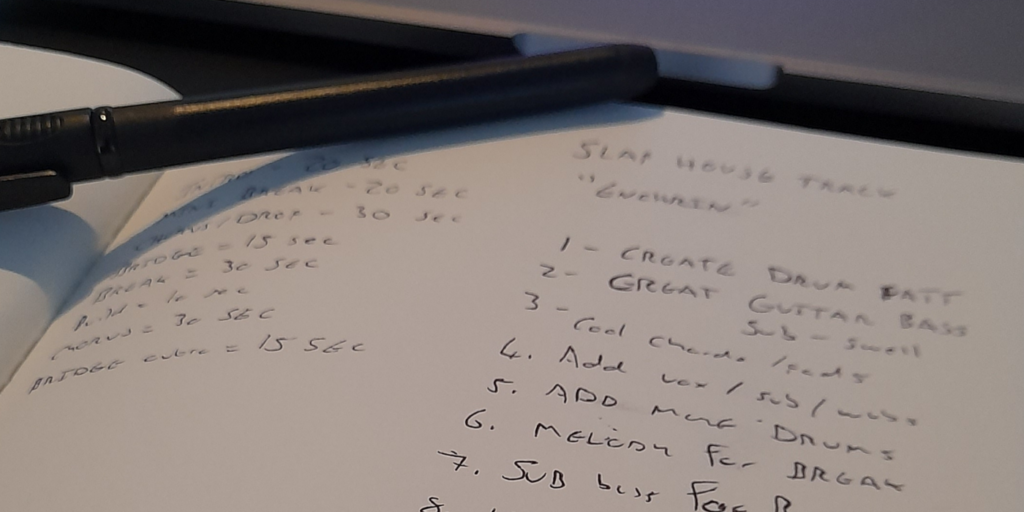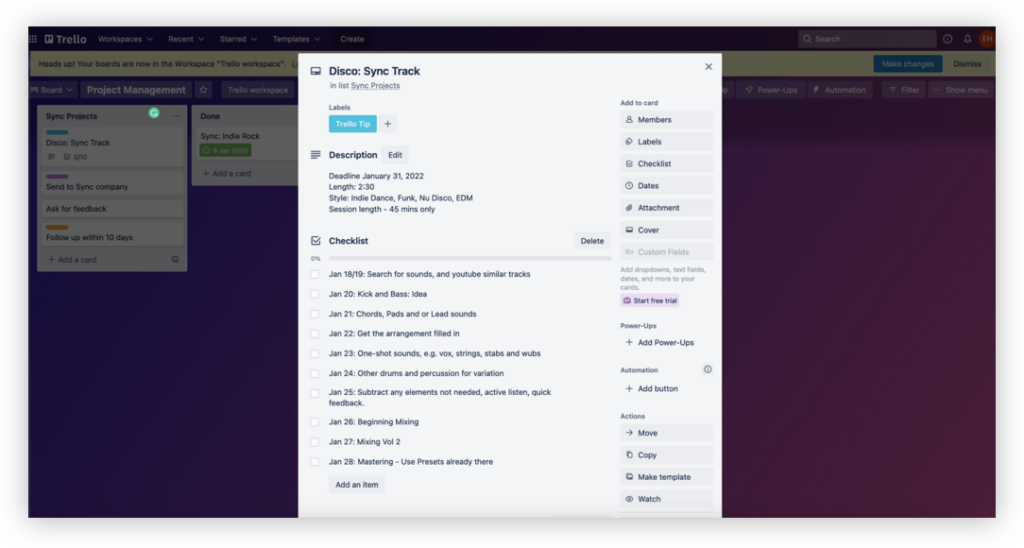Illustration: Tim Peacock
We’ve all been there—the sense of dread when you’re working on an idea, but can’t get it over the finish line; the 16-bar loop just doesn’t expand beyond the remits of your DAW.
It’s a nice feeling to be inspired, and having the time to get granular with an idea is also important. But truthfully, if you’re someone who regularly makes music, how many ideas do you have in your DAW right now that you’re struggling to get over the finish line?
I’ve been in this very cycle recently, and have spent hours sourcing online tutorials, self-help books unrelated to music, and even DAW strategy books. In this article, I share what ultimately worked for me in respect to getting my own tracks over the finish line, with the hope that you’ll also take some benefit from these practices.
1. Stop chasing perfection
The perfect is the enemy of the good. —Voltaire
No matter how many hours you spend tweaking the EQ on your kick drum, the majority of people who will hear the final track unfortunately won’t appreciate it or see your efforts.
I’m a huge fan of those stalwart producers who take pride in the small technical details when producing music. They’re true craftspeople, and should not be shunned. That said, in the context of this discussion, no matter how many hours you spend revising and editing, there are always going to be tweaks, corrections, and empty thoughts of adding another layer or percussion element to your already solid piece of music.
In the end, if you want to get your tracks over the finish line, you need to take a step back and practice acceptance—the idea that if you keep tweaking, you’ll never be done. I like the concept that I read about in Beth Kempton’s book Wabi Sabi—a part of Japanese culture that promotes the aesthetic of imperfection through transience and human error.
The whole point of exercising acceptance (Amor Fati) and embracing imperfections is not to ruin your chances of a career by putting out bad pieces of music. Rather, it’s about being able to move on to the next part of the project and speed up the process, so you’re not hanging around with a sense of imposter syndrome or letting failure cast doubt over your ability to be creative and flourish.
Moving on can sometimes be the best path to growth
Even if it’s not ‘perfect,’ having a track that you’re content with will increase the chances of you moving on to your next project to create something even better. And keep in mind that while it’s not the end of the world to have every element polished to ‘perfection,’ and things like mixing and mastering are important to familiarize yourself with, they can also be outsourced.
The house party listening to a Spotify playlist in Brazil or the people dancing at a live show in Austin typically won’t critique your sound design, as long as you’ve got the guts of your idea into a nice, groove-able arrangement.
Plus, so what if they do? The fact that you’ve got a track out there is something to be proud of, and people’s impressions are par for the course—some will like it, while others will critique. Life moves on. While you can influence them, outcomes and perceptions ultimately aren’t up to you.
2. Be consistent and keep showing up
Genius is 1% inspiration and 99% percent perspiration. —Thomas Edison
Unfortunately, for most of us inspiration won’t just strike on command, and we may or may not instantly get that great hook or phrasing from one session. Many artists and record producers turn to various methods of writing music, and will go to any lengths to get that spark of inspiration.
A common misconception is that you need inspiration to create good music. If you’re fortunate enough to have those periods of inspiration, that’s great—by all means go for it and get into your flow. You should hold on to them as much as possible, as these moments are few and far between for most.
For everyone else, we shouldn’t immediately categorize the lack of inspiration as “creative block” and ride that wave. Like most things in life, anything worth doing won’t be easy. If you want to make music and fully finish your ideas, you’ll need to find an effective process and work hard. Like the progressing martial artist or the avid gym fanatic, the more you show up, the more likely you’ll have a chance at progressing and growing.
Using iterative production to get tracks over the finish line
For me, having my DAW constantly open with a MIDI keyboard connected and internal plugins running motivates me to spend at least 30 minutes creating music. Despite the fact that some days I might not get out of a chord sequence or a drum pattern, I still have something to return to the following day, instead of always starting from nothing.
Some will call this iterative production, which involves starting with something simple (like what’s mentioned above) and turning it into a series of small additions and adjustments. The end result of that ‘session’ is not an amazing composition, but consistent and measurable progress. This can make a huge difference for your ability to get tracks over the finish line.
One additional technique I’ve found helpful is to block 15 minutes off in the afternoon, where my brain is typically automatically trying to procrastinate. It’s a solid way to give your brain a chance to rest, away from all the admin and chaos. This of course will be different for you depending on your work / life balance and day-to-day schedule.
From there, I’ll open up my DAW and close down everything else, and I’ll let my mind wander and my thoughts flow freely. Not only does this help you mentally recharge, but it can often help with a creative breakthrough, or a spark of inspiration might come if I’m fortunate enough.
It’s important to place a spot on your calendar for “creative thinking time” (I usually write in my journal), as it assists in driving home the consistency element of repeating three or four times a week.
3. Arrange, arrange, and arrange
I’m really inspired by sculpture, so I like to say, “You’re not making music, you’re creating a space.” You’re building a room, putting some objects in it, and seeing what happens to the objects over time. —Daniel Lopatin
The process of arrangement is crucial for any songwriter or producer. While arranging is fundamentally about structuring and therefore an additive process, you should also focus on it as an opportunity to subtract.
A method I find effective is to focus on arranging my tracks at the start of the process, and then prioritize the mix and other elements from there. Beginning your productions by ensuring that all the elements of your song fit together is a great way to ensure that the core qualities of the piece—including hook and melodic structure—are there without the bells and whistles to prop it up.
Provided you have the core sounds and ideas in place, you can then begin filling the arrangement view window with what you have. Think of the average length of a song in your genre, and fill out the space accordingly without too much thought. Luckily, most DAWs have a simple copy, paste, or extend clip command, which makes this fairly simple.
This process should take less than one minute to complete. It’s important to resist the urge to immediately dive into organizing and chopping. It’s similar to the process in music production called maximal density, where you throw the kitchen sink at your production, and stack all of your elements together in a bid to then weed out unnecessary sounds.
The benefits of employing a subtractive approach
Once this process is complete, in theory, you should have a block of material to chip away at or subtract from, which should in turn give you the outline of your track. It’s especially great for hearing what works together, what’s too overpowering, and what just doesn’t click.
If the music sounds too minimal or sparse for your required genre or taste, you can then add an element or two as necessary, rather than overpopulate your DAW with too many channels from the get-go. Fullness in a piece of music is often achieved with compositional balance, rather than too many things competing for the same space.

A go-to template I use for arranging my tracks quickly
Not only does this approach help you finish your music, but it can also be beneficial to the mixing and editing processes later on. Sculpting from your arrangement can help take your mind off the detail-orientated stage of tweaking, and allow you to immediately see the bigger picture. When it comes time to mix, this should be helpful as you have an overarching sense of what the raw audio needs.
One final tip here is to try importing a song that you’re already familiar with in your chosen genre, and use it as a reference point for length and structure. This is known as A/Bing, and usually occurs when mixing and mastering tracks, but I’ve found it useful for arrangement as well.
4. Make a list, and check it twice
Remember that our own worth is measured by what we devote our energy to. —Marcus Aurelius
Something that can revolutionize the way you create and ultimately get tracks over the finish line is grabbing a notebook and pen and making lists about your music. This can work in two ways: it can (1) allow you to plan what you need to add or subtract while in a listening feedback session, or (2) help you schedule a point in your day where you need to work on a particular section of your track.

My written notes about a new track I’m working on
This technique allows you to avoid excessive screen time and endlessly staring at your arrangement. Plus, having concrete notes on what you need to work on as soon as you open up that session will help you finish sections faster. I know a lot of people who also use Trello boards when planning their releases, and I’ve used them to work on my own tracks from start to finish.
Whatever you do, make sure you set out with a designated timeframe for creating or listening to feedback. I normally choose 30-minute or 45-minute sessions for creating or mixing, and most of the time, I achieve some form of progress. I can also split this over two days, which allows me to listen with fresh ears.

One of my recent Trello board ladder checklists
Psychologically speaking, writing things down can really help you progress with making music as well as other areas of your life. Five minutes spent on organizing your diary or online production checklist will not only make you feel better, but also embed into your psyche that you have something to finish off with haste.
Getting your tracks over the finish line: Conclusion
When you hear the old adage about a cat needing to be rescued out of a tree, what’s the tool that most reach for? Having a metaphorical ladder in place can drive home the notion of a completed piece of music, as opposed to another unfinished idea.
You might not always have the motivation to get that track you’re working on over the finish line. But, having a clear mind and concrete next step when it comes to creating and editing will eventually help you move on to the next section, therefore getting you closer to getting your music out of the DAW, and into the world.
Explore royalty-free sounds from leading artists, producers, and sound designers:
April 22, 2022

.svg)
.svg)




